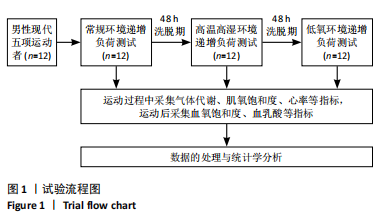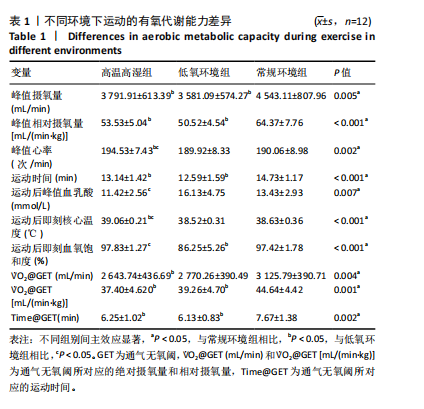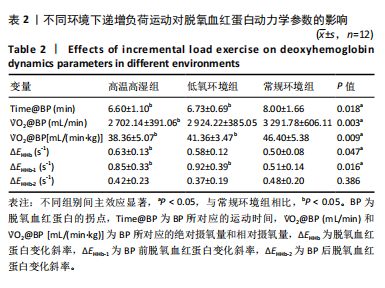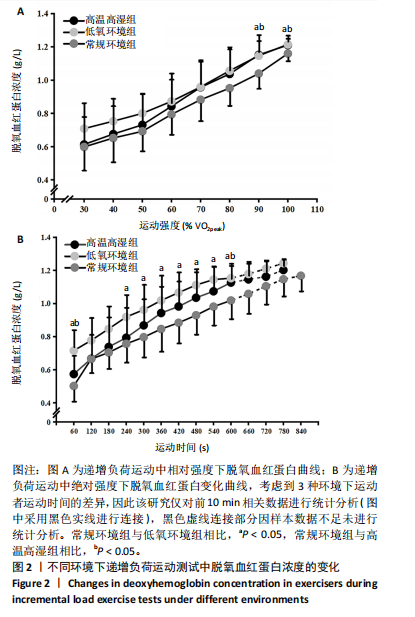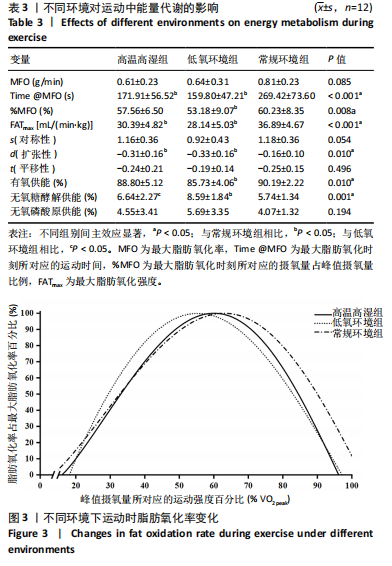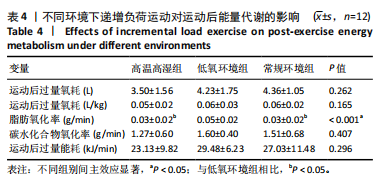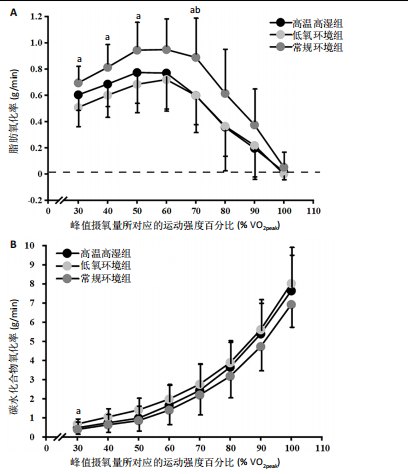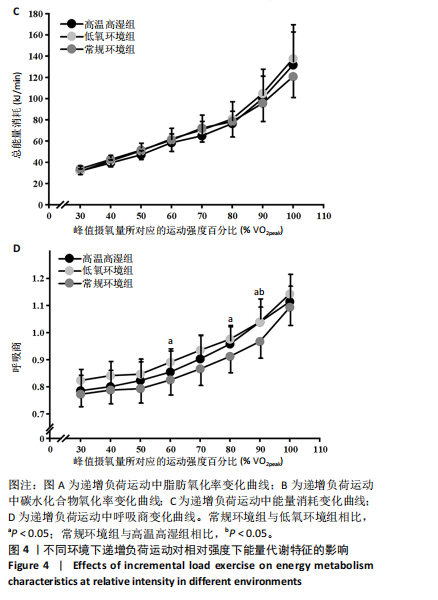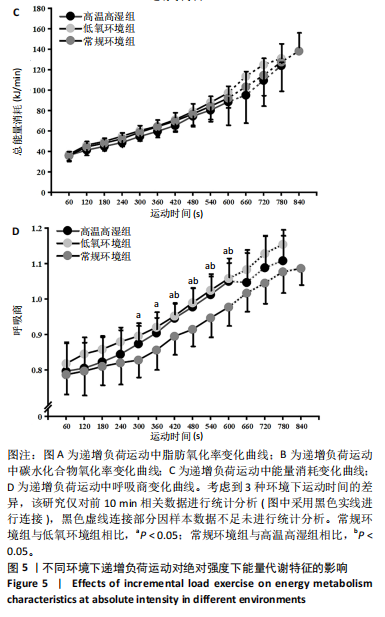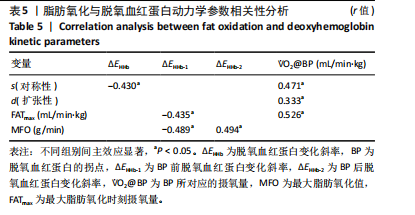[1] 赵杰修,张漓,路瑛丽,等.高原(低氧)和高温环境下运动训练生理生化监控研究进展[J].中国运动医学杂志,2016,35(12):1165-1171.
[2] GENG Z, WANG J, CAO G, et al. Differential impact of heat and hypoxia on dynamic oxygen uptake and deoxyhemoglobin parameters during incremental exhaustive exercise. Front Physiol. 2024;14:1247659.
[3] TWOMEY R, WRIGHTSON J, FLETCHER H, et al. Exercise-induced Fatigue in Severe Hypoxia after an Intermittent Hypoxic Protocol. Med Sci Sports Exerc. 2017;49(12):2422-2432.
[4] ROWELL LB, O’LEARY DS, KELLOGG DL. Integration of cardiovascular control systems in dynamic exercise. Compr Physiol. 2010:770-838.
[5] YOUNG AJ. Energy substrate utilization during exercise in extreme environments. Exerc Sport Sci Rev. 1990;18:65-117.
[6] 周祎,赵凡.高温高湿对比一般环境有氧运动对摔跤运动员能量代谢和力量素质的影响[J].中国体育科技,2015,51(6):108-113.
[7] GAGNON DD, PERRIER L, DORMAN SC, et al. Ambient temperature influences metabolic substrate oxidation curves during running and cycling in healthy men. Eur J Sport Sci. 2020;20(1):90-99.
[8] RUÍZ-MORENO C, GUTIÉRREZ-HELLÍN J, GONZÁLEZ-GARCÍA J, et al. Effect of ambient temperature on fat oxidation during an incremental cycling exercise test. Eur J Sport Sci. 2021;21(8):1140-1147.
[9] BOWTELL JL, COOKE K, TURNER R, et al. Acute physiological and performance responses to repeated sprints in varying degrees of hypoxia. J Sci Med Sport. 2014;17(4):399-403.
[10] ZURBUCHEN A, LANZI S, VOIROL L, et al. Fat Oxidation Kinetics Is Related to Muscle Deoxygenation Kinetics During Exercise. Front Physiol. 2020;11:571.
[11] DANDANELL S, MEINILD-LUNDBY AK, ANDERSEN AB, et al. Determinants of maximal whole-body fat oxidation in elite cross-country skiers: Role of skeletal muscle mitochondria. Scand J Med Sci Sports. 2018;28(12):2494-2504.
[12] FRANDSEN J, VEST SD, LARSEN S, et al. Maximal Fat Oxidation is Related to Performance in an Ironman Triathlon. Int J Sports Med. 2017;38(13):975-982.
[13] 车开萱,邱俊强.脂肪适应有助于提升运动表现吗?[J].体育科学,2022, 42(3):85-90+97.
14] CHENEVIÈRE X, MALATESTA D, PETERS EM, et al. A mathematical model to describe fat oxidation kinetics during graded exercise. Med Sci Sports Exerc. 2009;41(8):1615-1625.
[15] SPENCER MD, MURIAS JM, PATERSON DH. Characterizing the profile of muscle deoxygenation during ramp incremental exercise in young men. Eur J Appl Physiol. 2012;112(9):3349-3360.
[16] VIETH E. Fitting piecewise linear regression functions to biological responses. J Appl Physiol (1985). 1989;67(1):390-396.
[17] LE MEUR Y, DOREL S, BAUP Y, et al. Physiological demand and pacing strategy during the new combined event in elite pentathletes. Eur J Appl Physiol. 2012; 112(7):2583-2593.
[18] HOFFMANN B, FLATT AA, SILVA LEV, et al. A Pilot Study of the Reliability and Agreement of Heart Rate, Respiratory Rate and Short-Term Heart Rate Variability in Elite Modern Pentathlon Athletes. Diagnostics (Basel). 2020;10(10):833.
[19] ARAÚJO CG, SCHARHAG J. Athlete: a working definition for medical and health sciences research. Scand J Med Sci Sports. 2016;26(1):4-7.
[20] STÖGGL TL, STREPP T, BLUMKAITIS J, et al. Unraveling the mystery of isocaloric endurance training - Influence of exercise modality, biological sex, and physical fitness. Metabolism. 2023;144:155582.
[21] SEDLOCK DA, LEE MG, FLYNN MG, et al. Excess postexercise oxygen consumption after aerobic exercise training. Int J Sport Nutr Exerc Metab. 2010;20(4):336-349.
[22] 邱俊,陈文鹤.高住低训和高原训练对优秀现代五项运动员运动能力的影响[J].上海体育学院学报,2011,35(1):67-72.
[23] YAMAGUCHI K, SUMI D, HAYASHI N, et al. Effects of combined hot and hypoxic conditions on muscle blood flow and muscle oxygenation during repeated cycling sprints. Eur J Appl Physiol. 2021;121(10):2869-2878.
[24] SAITOH T, OOUE A, KONDO N, et al. Active muscle oxygenation dynamics measured during high-intensity exercise by using two near-infrared spectroscopy methods. Adv Exp Med Biol. 2010;662:225-230.
[25] SORIA M, GONZÁLEZ-HARO C, LÓPEZ-COLÓN JL, et al. Submaximal exercise intensities do not provoke variations in plasma magnesium concentration in well-trained euhydrated endurance athletes with no magnesium deficiency. Magnes Res. 2011;24(2):36-44.
[26] BEAVER WL, WASSERMAN K, WHIPP BJ. A new method for detecting anaerobic threshold by gas exchange. J Appl Physiol (1985). 1986;60(6):2020-2027.
[27] ISLAM H, TOWNSEND LK, HAZELL TJ. Excess Postexercise Oxygen Consumption and Fat Utilization Following Submaximal Continuous and Supramaximal Interval Running. Res Q Exerc Sport. 2018;89(4):450-456.
[28] JEUKENDRUP AE, WALLIS GA. Measurement of substrate oxidation during exercise by means of gas exchange measurements. Int J Sports Med. 2005;26 Suppl 1:S28-37.
[29] VALLERAND AL, JACOBS I. Rates of energy substrates utilization during human cold exposure. Eur J Appl Physiol Occup Physiol. 1989;58(8):873-878.
[30] KAUFMANN S, ZIEGLER M, WERNER J, et al. Energetics of Floor Gymnastics: Aerobic and Anaerobic Share in Male and Female Sub-elite Gymnasts. Sports Med Open. 2022;8(1):3.
[31] 章凌凌,黄鹏,吴雪萍,等.二种方法对男子轮椅竞速T54级比赛项目能量供应计算结果的比较[J].中国应用生理学杂志,2020,36(1):27-32.
[32] BERTUZZI RC, FRANCHINI E, UGRINOWITSCH C, et al. Predicting MAOD using only a supramaximal exhaustive test. Int J Sports Med. 2010;31(7):477-481.
[33] OZYENER F, ROSSITER HB, WARD SA, et al. Influence of exercise intensity on the on- and off-transient kinetics of pulmonary oxygen uptake in humans. J Physiol. 2001;533(Pt 3):891-902.
[34] AZEVEDO RDA, J E BS, INGLIS EC, et al. Hypoxia equally reduces the respiratory compensation point and the NIRS-derived [HHb] breakpoint during a ramp-incremental test in young active males. Physiol Rep. 2020;8(12):e14478.
[35] OSAWA T, KIME R, HAMAOKA T, et al. Attenuation of muscle deoxygenation precedes EMG threshold in normoxia and hypoxia. Med Sci Sports Exerc. 2011; 43(8):1406-1413.
[36] LINNARSSON D, KARLSSON J, FAGRAEUS L, et al. Muscle metabolites and oxygen deficit with exercise in hypoxia and hyperoxia. J Appl Physiol. 1974;36(4):399-402.
[37] OSAWA T, ARIMITSU T, TAKAHASHI H. Hypoxia affects tissue oxygenation differently in the thigh and calf muscles during incremental running. Eur J Appl Physiol. 2017;117(10):2057-2064.
[38] BOWEN TS, KOGA S, AMANO T, et al. The Spatial Distribution of Absolute Skeletal Muscle Deoxygenation During Ramp-Incremental Exercise Is Not Influenced by Hypoxia. Adv Exp Med Biol. 2016;876:19-26.
[39] AZEVEDO RA, BÉJAR SAONA JE, INGLIS EC, et al. The effect of the fraction of inspired oxygen on the NIRS-derived deoxygenated hemoglobin “breakpoint” during ramp-incremental test. Am J Physiol Regul Integr Comp Physiol. 2020; 318(2):R399-R409.
[40] DENNIS MC, GOODS PSR, BINNIE MJ, et al. Increased air temperature during repeated-sprint training in hypoxia amplifies changes in muscle oxygenation without decreasing cycling performance. Eur J Sport Sci. 2023;23(1):62-72.
[41] PÉRIARD JD, THOMPSON MW, CAILLAUD C, et al. Influence of heat stress and exercise intensity on vastus lateralis muscle and prefrontal cortex oxygenation. Eur J Appl Physiol. 2013;113(1):211-222.
[42] RACINAIS S, COCKING S, PÉRIARD JD. Sports and environmental temperature: From warming-up to heating-up. Temperature (Austin). 2017;4(3):227-257.
[43] TRINITY JD, PAHNKE MD, LEE JF, et al. Interaction of hyperthermia and heart rate on stroke volume during prolonged exercise. J Appl Physiol (1985). 2010; 109(3):745-751.
[44] 季泰,袁伟琪,王坤,等.热环境下运动人体热感觉研究进展[J].中国体育科技,2022,58(4):73-80.
[45] MORRISON SF. Central control of body temperature. F1000Res. 2016;5:F1000.
[46] GORDAN R, GWATHMEY JK, XIE LH. Autonomic and endocrine control of cardiovascular function. World J Cardiol. 2015;7(4):204-214.
[47] YAMAGUCHI K, IMAI T, YATSUTANI H, et al. A Combined Hot and Hypoxic Environment during Maximal Cycling Sprints Reduced Muscle Oxygen Saturation: A Pilot Study. J Sports Sci Med. 2021;20(4):684-689.
[48] MURIAS JM, SPENCER MD, KEIR DA, et al. Systemic and vastus lateralis muscle blood flow and O2 extraction during ramp incremental cycle exercise. Am J Physiol Regul Integr Comp Physiol. 2013;304(9):R720-725.
[49] IANNETTA D, OKUSHIMA D, INGLIS EC, et al. Blood flow occlusion-related O2 extraction “reserve” is present in different muscles of the quadriceps but greater in deeper regions after ramp-incremental test. J Appl Physiol (1985). 2018;125(2):313-319.
[50] INGLIS EC, IANNETTA D, MURIAS JM. Evaluating the NIRS-derived microvascular O2 extraction “reserve” in groups varying in sex and training status using leg blood flow occlusions. PLoS One. 2019;14(7):e0220192.
[51] MURRAY AJ. Energy metabolism and the high-altitude environment. Exp Physiol. 2016;101(1):23-27.
[52] WORKMAN C, BASSET FA. Post-metabolic response to passive normobaric hypoxic exposure in sedendary overweight males: a pilot study. Nutr Metab (Lond). 2012;9(1):103.
[53] 太获田.低压低氧环境下大强度训练对代谢能力及运动能力的影响[J].体育科研,2009,30(6):12-15.
[54] GRIFFITHS A, DEIGHTON K, SHANNON OM, et al. Substrate oxidation and the influence of breakfast in normobaric hypoxia and normoxia. Eur J Appl Physiol. 2019;119(9):1909-1920.
[55] GRIFFITHS A, SHANNON OM, MATU J, et al. The effects of environmental hypoxia on substrate utilisation during exercise: a meta-analysis. J Int Soc Sports Nutr. 2019;16(1):10.
[56] CHENEVIÈRE X, MALATESTA D, GOJANOVIC B, et al. Differences in whole-body fat oxidation kinetics between cycling and running. Eur J Appl Physiol. 2010; 109(6):1037-1045.
[57] JEUKENDRUP AE. Regulation of fat metabolism in skeletal muscle. Ann N Y Acad Sci. 2002;967:217-235.
[58] STARRITT EC, HOWLETT RA, HEIGENHAUSER GJ, et al. Sensitivity of CPT I to malonyl-CoA in trained and untrained human skeletal muscle. Am J Physiol Endocrinol Metab. 2000;278(3):E462-E468.
[59] 魏婷,张永煜,张庆华.肉毒碱棕榈酰基转移酶1A的研究进展[J].生命科学,2013,25(6):614-620.
[60] KELLY LP, BASSET FA. Acute Normobaric Hypoxia Increases Post-exercise Lipid Oxidation in Healthy Males. Front Physiol. 2017;8:293.
[61] NYBO L, JENSEN T, NIELSEN B, et al. Effects of marked hyperthermia with and without dehydration on VO(2) kinetics during intense exercise. J Appl Physiol (1985). 2001;90(3):1057-1064.
[62] LUNDBY C, VAN HALL G. Substrate utilization in sea level residents during exercise in acute hypoxia and after 4 weeks of acclimatization to 4100 m. Acta Physiol Scand. 2002;176(3):195-201.
[63] MATU J, DEIGHTON K, ISPOGLOU T, et al. The effect of moderate versus severe simulated altitude on appetite, gut hormones, energy intake and substrate oxidation in men. Appetite. 2017;113:284-292.
[64] PURGE P, LEHISMETS P, JÜRIMÄE J. A new method for the measurement of maximal fat oxidation: A pilot study. Acta Kinesiologiae Universitatis Tartuensis. 2014;20:90-99.
[65] TAHARA Y, MOJI K, HONDA S, et al. Fat-free mass and excess post-exercise oxygen consumption in the 40 minutes after short-duration exhaustive exercise in young male Japanese athletes. J Physiol Anthropol. 2008;27(3):139-143. |
